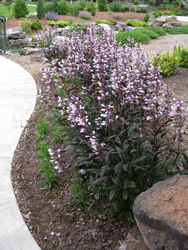Resource Library
Plant of the Week: Penstemon, Dark Towers
The University of Arkansas System Division of Agriculture does not promote, support or recommend plants featured in "Plant of the Week." Please consult your local Extension office for plants suitable for your region.
Plant of the Week
Dark Towers Penstemon

New plants come and go in our gardens with stunning regularity, as corporate marketers feed the craze and try to keep something new and exciting in the pipeline for gardeners to try. Many of these new plants are one-shot-wonders. They simply don't stand up to the test of time. However, Dark Towers Penstemon may beat the odds and become a favorite of the perennial border in years to come.
Penstemon 'Dark Towers' (PP 20,013 filed in 2007) is a new hybrid cross between P. digitalis 'Husker Red' and P. 'Prairie Splendor' (P. cobaea x P. triflorus). Penstemons are members of the snapdragon family, and are found throughout North America where the few that know them consider them wildflowers, not garden plants. But Dr. Dale Lindgren, a quiet, unassuming and very patient plant breeder at the University of Nebraska-Lincoln, has been working for almost three decades to change this perception.
Dark Towers, with intensely purple leaves and stems, grows upright to about 30 inches tall when it blooms in late spring and early summer. It has the general plant form of Lindgren's 1983 release 'Husker Red' which became a mainstay in many gardens because of the intensely purple leaves which provided strong contrast to the large, white flowers atop 3 foot tall stems. Leaves of Dark Towers are willow-shaped, to 3 inches long and produced up the flowering stem.
Dark Towers flowers are produced in a terminal panicle with 50- to 75-inch long blooms produced during the blooming season. From a distance the tubular flowers appear to be white, but closer inspection reveals the basal part of the tube to be suffused with shades of purple. Because the plant is a hybrid, it is sterile, so plants remain in bloom over a longer season than typical for penstemons.
Penstemons are found throughout North America, where 388 species or varieties have been described by botanists. The greatest majority of these grow in the drier, mountainous states or the prairies, but P. digitalis avoids the dry lands of the West and is the most common eastern species, where its distribution matches that of the eastern deciduous forest. It is not a shade plant, though, instead growing in sunny glades and along roadsides. Dark Towers derives its adaptability to typical garden soils from this species.
Penstemons are an interesting group of plants with their own fan club, the American Penstemon Society. The society has about 400 members and is one of the oldest specialty plant groups, being established in 1945. This group of nature lovers, serious rock gardeners and professional botanists does the usual things associated with plant societies, such as publish newsletters and a journal, have a seed exchange and hold an annual meeting. But their annual meeting is no stuffy series of lectures. Instead, attendees are treated to a two-day wildflower hunt in various parts of the nation where penstemons grow wild. The 2010 meeting was in Craig, Colo., where we saw six species of mostly endemic penstemons growing in the high desert basin of the northwestern part of the state.
Dark Towers Penstemon will probably replace Husker Red in gardens, as it stands better in garden situations without staking and it flowers over a longer season. Also, because it is sterile, it does not reseed in the garden, as will happen with Husker Red. Plants do best in sunny sites with an average, well-drained garden soil. Once established, they have good drought tolerance. Snipping plants back after their first flowering may induce a second bloom cycle. Individual plants are long-lived and maintain good vigor without division for three to five years.
By: Gerald Klingaman, retired
Extension Horticulturist - Ornamentals
Extension News - June 18, 2010
The University of Arkansas System Division of Agriculture does not maintain lists of retail outlets where these plants can be purchased. Please check your local nursery or other retail outlets to ask about the availability of these plants for your growing area.